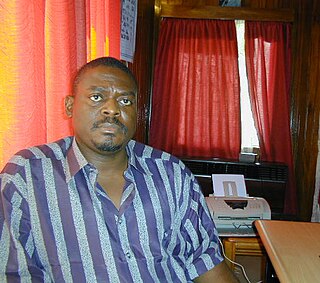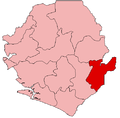Geography
Jawei Chiefdom is located on the southwestern edge of Kailahun District, bordering Dama Chiefdom and Gaura Chiefdom of Kenema District to the southwest. Jawei borders Jaluahun Chiefdom to the northwest, Mandu Chiefdom to the northeast, and Malema Chiefdom to the southeast. The Moa River transects the chiefdom.
Settlements
The other important town in Jawei Chiefdom is Benduma. Villages in Jawei dChiefdom include Bombohun, Nyedehun, Gbajorma, Tomboma, Folu, Giehun, Guma,Karlu, Karlu Kambama, Kutoma, Manowah, Mamabu, Bembeyeima, Pellie and Potoru, nyeama
Economy
The economy is primarily agricultural; however there is some mining. The primary export is palm oil.
Civil war
During the 1991-2002 civil war various villages in northern Jawei Chiefdom were occupied by the Revolutionary United Front (RUF) and National Patriotic Front of Liberia ((NPFL)) during their initial on-thrust in Spring 1991. The RUF got as far as Benduma, but did not attack Daru or the Moa Barracks across the river, where the Sierra Leone Army (SLA) was based. Guinean troops soon arrived in Daru to support the SLA. The Guineans attacked and drove the RUF out of Benduma, after which battle neither side stationed troops there. [2] In June 1991, RUF and NPFL attacked the Moa Barracks at Daru, but despite the gallantry of the NPFL commander, who was killed on the bridge over the Moa, the Guinean troops and the SLA turned back the assault. [3] Fighting continued in Jawei Chiefdom over the next two years with little change in territory. In December 1992, after an almost successful RUF attack on nearby Segbwema in Jaluahun Chiefdom, some of the Guinean troops were sent from the Moa Barracks to Segbwema. [4] At that same time local hunters, often members of secret hunting societies, began to form into auxiliary units to assist the SLA in Jawei Chiefdom. [5] Finally in May 1993, the SLA with the assistance of these "civilian" units were able to dislodge the RUF from their bases in northern Jawei. [5]
Nonetheless, RUF guerrilla warfare continued in the chiefdom and it was still considered unsafe during the February 1996 elections. [6] Shortly after the election, local chiefs were encouraged to send their young men to Kamajor society initiations after which they were formed into Civil Defence Forces (CDF) units. Prior to this the local hunters were under the command of their own chiefs, but this changed them into a state force. With this new status the Jawei CDF units began attacking RUF positions without SLA support. [7] By January 1997, some Jawei forces were fighting as far away as Upper Bambara Chiefdom. [8] By September 1997 the Jawei Kamajors had all of Jawei Chiefdom under their control and the guerrilla war there ceased. [9]
In March 1998, Nigerian ECOMOG forces arrived in Daru to support the Kamajors. But this had the effect of drawing combined RUF and Armed Forces Revolutionary Council (AFRC) forces to attack Daru which they did several times during 1998 and early 1999. [10] The last such attack was on 7 July 1999, just two days before the ceasefire mandated in the Lomé Peace Accord. [11] But the fighting continued anyway with the Kamajors attacking RUF/AFRC positions at Daru Junction on 17 July, driving them out. But the RUF/AFRC recaptured Daru Junction a month later. [11]
In Spring 2000 with the arrival of UNAMSIL personnel disarmament started in Jawei Chiefdom, where a Disarmament, Demobilisation and Reintegration Camp had been set up in November the previous year. [12] But it was interrupted in May by resistance to the northeast. The process was only restarted in late July. [13]

Foday Saybana Sankoh was the founder of the Sierra Leone rebel group Revolutionary United Front (RUF), which was supported by Charles Taylor-led NPFL in the 11-year-long Sierra Leone Civil War, starting in 1991 and ending in 2002. An estimated 50,000 people were killed during the war, and over 500,000 people were displaced in neighboring countries.

Major Johnny Paul Koroma was a Sierra Leonean military officer who was the head of state of Sierra Leone from May 1997 to February 1998.
Valentine Esegragbo Melvine Strasser is a former Sierra Leonean military officer who served as head of state of Sierra Leone from 1992 to 1996. He became the world's youngest Head of State in 1992, seizing power three days after his 25th birthday.
The Armed Forces Revolutionary Council (AFRC) was a group of Sierra Leone soldiers that allied itself with the rebel Revolutionary United Front in the late 1990s. While the AFRC briefly controlled the country in 1998, it was driven from the capital by an international military intervention of the Economic Community of West African States Monitoring Group (ECOMOG). It was no longer a coherent and effective organization by the elections of 2002.
The Sierra Leone Civil War (1991–2002), or the Sierra Leonean Civil War, was a civil war in Sierra Leone that began on 23 March 1991 when the Revolutionary United Front (RUF), with support from the special forces of Liberian dictator Charles Taylor's National Patriotic Front of Liberia (NPFL), intervened in Sierra Leone in an attempt to overthrow the Joseph Momoh government. The resulting civil war lasted 11 years, enveloping the country. It left over 50,000 dead.
Kangama is a town in Kailahun District in the Eastern Province of Sierra Leone, near the border of Liberia. It is the headquarters of the Kissi Teng Chiefdom.
The Kamajors were a group of traditional hunters from the Mende ethnic group in the south and east of Sierra Leone. The word "Kamajor" derived from Mende "kama soh", meaning traditional hunter with mystical powers, who were originally employed by local chiefs.
Samuel Sam Bockarie, widely known as Mosquito, was a Sierra Leonean politician and army commander who served as a leader of the Revolutionary United Front (RUF). Bockarie was infamous during the Sierra Leone Civil War for his brutal tactics, which included amputation, mutilation, and rape. He earned the nickname "Mosquito" for his ability to attack when his enemies were off-guard, mainly during the night. During his service in the RUF, he befriended future Liberian president Charles Taylor, and RUF commander Foday Sankoh. When Sankoh was imprisoned from March 1997 until April 1999, Bockarie served as commander of the RUF in his place.

The Eastern Province is one of the four provinces of Sierra Leone. It covers an area of 15,553 km2 and has a population of 1,641,012. Its capital and administrative centre is Kenema. Eastern Province, the centre of the country's diamond mining industry, is very mountainous and has two ranges, the Gola Hills and the Loma Mountains.
The Civil Defense Forces (CDF) was a paramilitary organization that fought in the Sierra Leone Civil War (1991–2002). It supported the elected government of Ahmed Tejan Kabbah against the rebel groups Revolutionary United Front (RUF) and Armed Forces Revolutionary Council (AFRC). Much of the CDF was made up of the Kamajors group, which is part of the larger Mende ethnic group. The Kamajors believed in many magical ways of defending themselves, such as rituals to create bulletproof skin.

Kailahun District is a district in the Eastern Province of Sierra Leone. Its capital and largest city is the town of Kailahun. The second most populous city in the district is Segbwema. Other major towns in Kailahun District include Koindu, Pendembu and Daru. As of the 2015 census, the district had a population of 525,372. Kailahun District is subdivided into fourteen chiefdoms.
Segbwema is a town in Kailahun District in the Eastern Province of Sierra Leone. The town is a major business and agricultural centre. Segbwema lies approximately 20 miles northeast of Kenema and about 225 miles south-east of Freetown. The population of Segbwema was 7,961 in the 2004 census with a current estimate of 16,532.
Daru is a town in Kailahun District in the Eastern Province of Sierra Leone with a population of 5,958 Daru lies approximately 25 miles to Kenema
Operation Khukri was a multinational operation launched in the United Nations Mission in Sierra Leone (UNAMSIL), involving India, Ghana, Britain and Nigeria. The aim of the operation was to break the two-month-long siege laid by armed cadres of the Revolutionary United Front (RUF) around two companies of 5/8th Gorkha Rifles Infantry Battalion Group of the Indian Army at Kailahun by effecting a fighting breakout and redeploying them with the main battalion at Daru.
Yenga is a village in Kissi Teng Chiefdom, Kailahun District in the Eastern province of Sierra Leone. The village is at the international border between Sierra Leone and Guinea.
Kissi Tongi Chiefdom is a chiefdom in Kailahun District of Sierra Leone with a population of 33,457. Its principal town is Buedu. During the Sierra Leone Civil War the Kissi Tongi Chiefdom was one of the major strongholds of the Revolutionary United Front (RUF). The War Office of the RUF was opened in Buedu in February 1998, and Kissi Tongi was one of the last chiefdoms to be disarmed in January 2002.
Kissi Teng Chiefdom is a chiefdom in Kailahun District of Sierra Leone with a population of 30,455. Its largest town is Koindu, but its headquarters is in Kangama. The major industry in Kissi Teng Chiefdom is farming. The population of Kissi Teng Chiefdom is largely from the Kissi ethnic group.
The United Kingdom began a military intervention in Sierra Leone on 7 May 2000 under the codename Operation Palliser. Although small numbers of British personnel had been deployed previously, Palliser was the first large-scale intervention by British forces in the Sierra Leone Civil War. In early May 2000, the Revolutionary United Front (RUF)—one of the main parties to the civil war—advanced on the country's capital, Freetown, prompting the British government to dispatch an "Operational Reconnaissance and Liaison Team" (ORLT) to prepare to evacuate foreign citizens. On 6 May, the RUF blocked the road connecting Freetown to the country's main airport, Lungi. The next day, British soldiers began to secure the airport and other areas essential to an evacuation. The majority of those who wished to leave were evacuated within the first two days of the operation, but many chose to stay following the arrival of British forces.
Jaluahun Chiefdom is a chiefdom in Kailahun District of Sierra Leone. Its capital is Segbwema.
Malema Chiefdom is a chiefdom in Kailahun District of Sierra Leone. Its capital is Jojoima.




